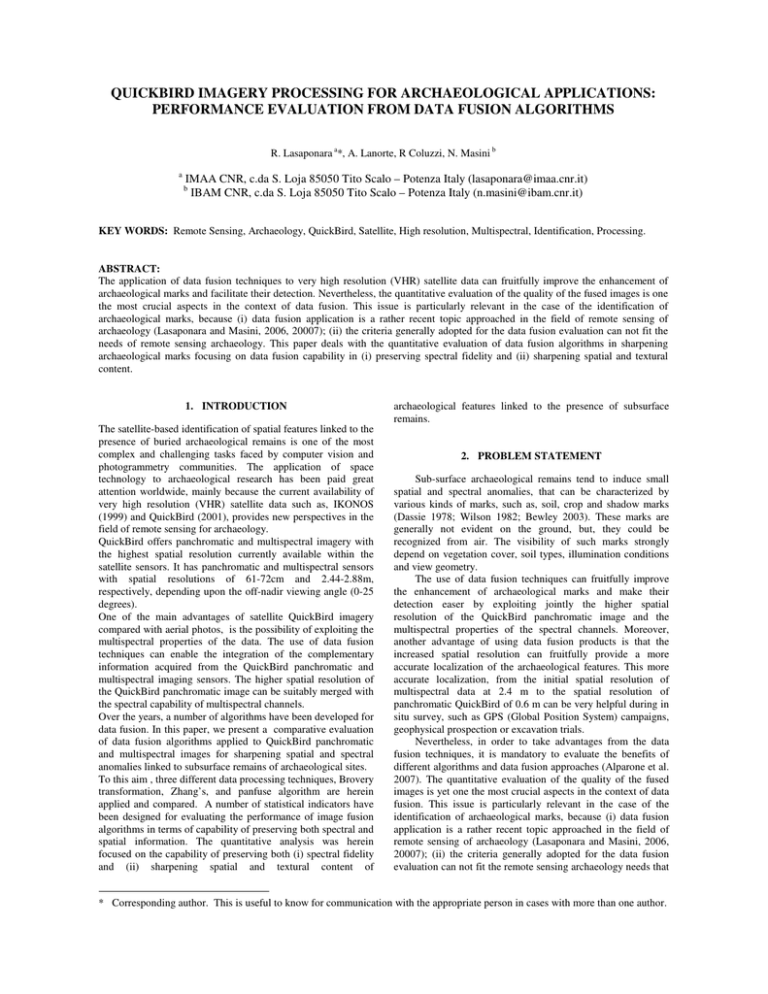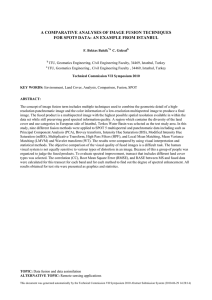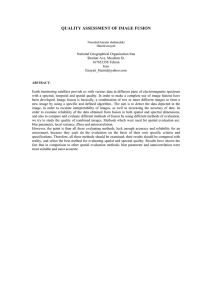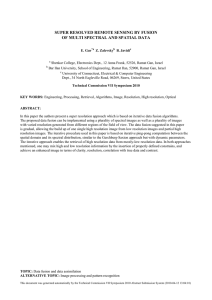QUICKBIRD IMAGERY PROCESSING FOR ARCHAEOLOGICAL APPLICATIONS:
advertisement

QUICKBIRD IMAGERY PROCESSING FOR ARCHAEOLOGICAL APPLICATIONS: PERFORMANCE EVALUATION FROM DATA FUSION ALGORITHMS R. Lasaponara a*, A. Lanorte, R Coluzzi, N. Masini b a IMAA CNR, c.da S. Loja 85050 Tito Scalo – Potenza Italy (lasaponara@imaa.cnr.it) IBAM CNR, c.da S. Loja 85050 Tito Scalo – Potenza Italy (n.masini@ibam.cnr.it) b KEY WORDS: Remote Sensing, Archaeology, QuickBird, Satellite, High resolution, Multispectral, Identification, Processing. ABSTRACT: The application of data fusion techniques to very high resolution (VHR) satellite data can fruitfully improve the enhancement of archaeological marks and facilitate their detection. Nevertheless, the quantitative evaluation of the quality of the fused images is one the most crucial aspects in the context of data fusion. This issue is particularly relevant in the case of the identification of archaeological marks, because (i) data fusion application is a rather recent topic approached in the field of remote sensing of archaeology (Lasaponara and Masini, 2006, 20007); (ii) the criteria generally adopted for the data fusion evaluation can not fit the needs of remote sensing archaeology. This paper deals with the quantitative evaluation of data fusion algorithms in sharpening archaeological marks focusing on data fusion capability in (i) preserving spectral fidelity and (ii) sharpening spatial and textural content. 1. INTRODUCTION The satellite-based identification of spatial features linked to the presence of buried archaeological remains is one of the most complex and challenging tasks faced by computer vision and photogrammetry communities. The application of space technology to archaeological research has been paid great attention worldwide, mainly because the current availability of very high resolution (VHR) satellite data such as, IKONOS (1999) and QuickBird (2001), provides new perspectives in the field of remote sensing for archaeology. QuickBird offers panchromatic and multispectral imagery with the highest spatial resolution currently available within the satellite sensors. It has panchromatic and multispectral sensors with spatial resolutions of 61-72cm and 2.44-2.88m, respectively, depending upon the off-nadir viewing angle (0-25 degrees). One of the main advantages of satellite QuickBird imagery compared with aerial photos, is the possibility of exploiting the multispectral properties of the data. The use of data fusion techniques can enable the integration of the complementary information acquired from the QuickBird panchromatic and multispectral imaging sensors. The higher spatial resolution of the QuickBird panchromatic image can be suitably merged with the spectral capability of multispectral channels. Over the years, a number of algorithms have been developed for data fusion. In this paper, we present a comparative evaluation of data fusion algorithms applied to QuickBird panchromatic and multispectral images for sharpening spatial and spectral anomalies linked to subsurface remains of archaeological sites. To this aim , three different data processing techniques, Brovery transformation, Zhang’s, and panfuse algorithm are herein applied and compared. A number of statistical indicators have been designed for evaluating the performance of image fusion algorithms in terms of capability of preserving both spectral and spatial information. The quantitative analysis was herein focused on the capability of preserving both (i) spectral fidelity and (ii) sharpening spatial and textural content of archaeological features linked to the presence of subsurface remains. 2. PROBLEM STATEMENT Sub-surface archaeological remains tend to induce small spatial and spectral anomalies, that can be characterized by various kinds of marks, such as, soil, crop and shadow marks (Dassie 1978; Wilson 1982; Bewley 2003). These marks are generally not evident on the ground, but, they could be recognized from air. The visibility of such marks strongly depend on vegetation cover, soil types, illumination conditions and view geometry. The use of data fusion techniques can fruitfully improve the enhancement of archaeological marks and make their detection easer by exploiting jointly the higher spatial resolution of the QuickBird panchromatic image and the multispectral properties of the spectral channels. Moreover, another advantage of using data fusion products is that the increased spatial resolution can fruitfully provide a more accurate localization of the archaeological features. This more accurate localization, from the initial spatial resolution of multispectral data at 2.4 m to the spatial resolution of panchromatic QuickBird of 0.6 m can be very helpful during in situ survey, such as GPS (Global Position System) campaigns, geophysical prospection or excavation trials. Nevertheless, in order to take advantages from the data fusion techniques, it is mandatory to evaluate the benefits of different algorithms and data fusion approaches (Alparone et al. 2007). The quantitative evaluation of the quality of the fused images is yet one the most crucial aspects in the context of data fusion. This issue is particularly relevant in the case of the identification of archaeological marks, because (i) data fusion application is a rather recent topic approached in the field of remote sensing of archaeology (Lasaponara and Masini, 2006, 20007); (ii) the criteria generally adopted for the data fusion evaluation can not fit the remote sensing archaeology needs that * Corresponding author. This is useful to know for communication with the appropriate person in cases with more than one author. are mainly focused on the identification of small features, that can be easily obscured by noise. The best results from data fusion is that the multispectral set of fused images should be as identical as possible to the set of multispectral images that the corresponding sensor (reference) would observe with the high spatial resolution of panchromatic. As no multispectral reference images are available at the requested higher spatial resolution, the assessment of the quality of the fused products is not obvious. Several score indices or figure metrics have been designed over the years (see, Thomas and Wald, 2007) to evaluate the performances of the fused images. Both intra-band indices and inter-band indices have been sep up in order to measure respectively, spatial distortions (radiometric and geometric distortions) and spectral distortions (colour distortions). In order to assess the performance of data fusion algorithms, three properties should be verified as expressed by Wald et al., PERS, 1997, Best Paper Award ’97: 1. The data fusion products, once degraded to their original resolution, should be equal to the original. 2. The data fusion image should be as identical as possible to the MS image that would be acquired by the corresponding sensor with the high spatial resolution of the Pan sensor. 3. The MS set of fused images should be as identical as possible to the set of MS images that would be acquired by the corresponding sensor with the high spatial resolution of Pan. As no multispectral reference images are available at the requested higher spatial resolution, the verification of the second and the third property is not obvious. In order to overcome this drawback, three different methodological approaches can be followed, the Wald protocol, the Zhou protocol, and, finally the QNR (Quality with No Reference) index devised by Alparone et al (2007). 2.1 Wald protocol In order to solve the problems linked to the unavailability of the multispectral reference images, Wald et al., (PERS, 1997, Best Paper Award ’97) see Alparone et al 2007 b, suggested a protocol to be applied in order to evaluate the quality of data usion products. Such a protocol is based on the following three steps: 1. spatial degradation of both the Pan and MS images by the same factor, 2. fusing the MS images at the degraded scale; 3. comparing the fused MS images with the originalreference MS images. The Wald protocol assumes a scale invariance behaviour. This means that performances of fusion methods are supposed to be invariant when fusion algorithms are applied to the full spatial resolution. Nevertheless, in the context of remote sensing of archaeology, the small features, which represent a large amount of the archaeological heritage, can be lost after degrading both the Pan and MS. In this situations, the archaeological feature will be missed, and, therefore, the evaluation of data fusion results could not be performed over the targets of interest. To avoid the degradation, one can considered the two alternative approaches described in section 2. 2 and 2.3. 2.2 Zhou protocol As an alternative to Wald's protocol, the problem of measuring the fusion quality may be approached at the full spatial scale without any degradation by applying Zhou’s Protocol (Zhou et al., IJRS, 1998). Such a protocol is based on the following three criteria: (1) Both the spectral and spatial qualities are evaluated, but by using separate scores from the available data: the first from the low resolution MS bands and the second one from the high resolution Pan image. (2) The evaluation of spectral quality is performed for each band by computing an absolute cumulative difference between the fused and the input MS images. (3) The evaluation of spatial quality is obtained as the correlation coefficient (CC) computed between the spatial details of the Pan image and of each of the fused MS bands. Such spatial details are extracted by using a Laplacian filter. Unfortunately, some problems can arise by using Zhou’s Protocol (Alparone et al. 2007b). Firstly, the two quality measures follow opposite trends. Secondly, at degraded scale, the obtained results can not be in agreement with objective quality indices. 2.3 QNR index Alparone et al. (2007) The QNR (Quality with No Reference) index devised by Alparone et al. (2007) is a “blind” index capable of jointly measuring the spectral and spatial quality at the full scale. This index should allow to overcome the drawbacks that can arise when using Zhou's protocol. The QNR computes both the spatial and spectral distortion from the quality index (Q) by Wang & Bovik (2002). This index combines the correlation coefficient with luminance and contrast distortion. It was devised for image fusion to assess the quality of output image, as well as for evaluating image processing systems and algorithms. Given an image X and its reference image Y, the quality index proposed by Wang, Bovik is calculated as: (2 µxµy + C1) (2 σxy +C2) Q= (1) ( µ2x+ µ2y + C1)(σ2x+ σ2y +C2) where C1=(k1*L)2 C2=(k2*L)2 µx and µy indicate the mean of the two images X and its reference image Y, σx and σy are the standard deviation, σx,y represents the covariance between the two images, and L is the dynamic range for the image pixel values, k1 << 1 and k2 << 1 are two constants chosen equal to 0.01 and 0.03, respectively. Although the values selected for k1 and k2 are arbitrary, It was experienced that the quality index is insensitive to variations of k1 and k2. Note that C1 and C2 are solely introduced to stabilize the measure. In other word, just to avoid the denominator approaches zero values for flat regions. To measure the overall image quality the mean quality index can be rewritten as a three factor product, that can be regarded are relatively independent. 3. DATA FUSION TECHNIQUES PROCESSING Q (x,y) = f(l(x,y), c(x,y), s(x,y))= (σxy +C2/2) (σxσy +C22) 2 µxµy + C1 2 2 ( µ x+ µ y + C1) 2(σxσy +C2) σ 2x+ (2) 2 σ y +C2 In particular, among the three factor of equation 2, the first (varying between -1 and 1) represents the correlation coefficient between the two image x and y; the second (varying between 0 and 1) measures the similarity between the mean luminance values of x and Y, and finally, the third (varying between 0 and 1) measures the contrast similarity. The rationale The QNR (Quality with No Reference) index devised by Alparone et al. (2007) is that the Q index calculated between any two spectral bands and between each band and the Pan image should be unchanged after fusion. In order to obtain a single index, both the spectral and spatial distortion indices are complemented and combined together to obtain a single index that measures the global quality of the fused image. In detail, the spectral distortion is computed as follows: • The spectral distortion is obtained by computing the difference of Q values from the fused MS bands and the input MS bands, re-sampled at the same spatial resolution as the Pan image • The Q is calculated for each couple of bands of the fused and re-sampled MS data to form two matrices with main diagonal equal to 1 • The measure of spectral distortion Dλ is computed by using a value proportional to the p-norm of the difference of the two matrices (3) where L is the number of the spectral bands processed, and denotes the Q is calculated for each couple of bands of the fused and resampled MS data The spatial distorsion is computed two times: 1) between each fused MS band and the Pan image; and than 2) between each input MS band and the spatially degraded Pan image. The spatial distortions Ds are calculated by a value proportional to the q-norm of the differences (4) where L is the number of the spectral bands processed, and denotes the Q is calculated between each fused MS band and the Pan image, and denotes the Q is calculated between each input MS band and the spatially degraded Pan image. 3.1 Zhang data fusion The fusion between the panchromatic QuickBird and the multispectral images of the data was performed by using a data fusion algorithm specifically developed for the VHR satellite images by Zhang (2004). The author found that all the existing data fusion approaches were not adequate for VHR satellite data for two main reasons (i) the colour distortion, and (ii) dataset dependency. Zhang (2004) devised a statistics-based fusion technique able to solve the two previously quoted problems in image. Such a data fusion algorithm is quite different from the other techniques in the following two principle ways: (i) Firstly, to reduce the colour distortion, it utilizes the least squares technique to find the best fit between the grey values of the image bands being fused and to adjust the contribution of individual bands to the fusion result; (ii) Secondly, to eliminate the problem of dataset dependency, it employs a set of statistic approaches to estimate the grey value relationship between all the input bands. This algorithm was adopted by Digital Globe http://www.pcigeomatics.com/support_center/tech_ papers/techpapers_main.php] and it is also available in a PCIGeomatica routine (PANSHARP). In the PANSHARP routine, if the original MS and Pan images are geo-referenced, the resampling process can also be accomplished together with the fusion within one step. All the MS bands can be fused at one time. The fusion can also be performed solely on user-specified MS bands. 3.2 Brovery transformation Brovery transformation is a numerical method to merge different source of data (Vrabel 1996, Liu 2000), which is implemented in the PCI software in the PANFUSE procedure. Brovery equation is designed on the basis of the assumption that spectral range of the panchromatic image is the same as that covered by multispecral data. The transformation is defined by equation 6. n Yk (i, j) = Xk (i, j) Xp (m, n)/ ∑ Xk (i, j) K=2 [5] where Yk (i, j) and Xk (i, j) are the kth fused multispectral band and the original multispectral band respectively.; I and j denote the pixel and line number respectively. Xp (m, n) is the original panchromatic band., and m, and n denote the pixel and line number. In the current case, the image fusion for quickbird data is carried as follows: (i) selection of spectral bands (ii) resample of them to panchromatic spatial resolution (iii) perform Brovery transformation for the resampled new image data The resulting image consist of a combination of the n multispectral bands and panchromatic image. 3.3 Image Fusion Image Fusion was designed to enhance the resolution and features of the multispectral low resolution image using the high resolution image as a reference. It is implemented in the PCI software. It works by computing the linear relationship between the two input images panchromatic and a given multispectral image over a window of size ((2 x KSIZE + 1) x 3) pixels centred around a given pixel. The correct KSIZE to use depends on the data set amount of structure and detail in the image. It is important to select the size of window keeping in mind that it will large enough, to obtain a statistically accurate correlation coefficient, and, at same time, small enough to reduce the effects of nearby edges yet. As a general rule a KSIZE less than 3 will enhance noise in the data fusion images, vice versa, a KSIZE greater than 7 may blur edges because of the offset in the correlation due to nearby. edges. In order to preserve the smal archaeological features, the the current case the KSIZE was set at 3 value. For each pixel, the correlation coefficient is calculated for both the horizontal and vertical kernels, but only the coefficient with the highest merit is used. If the merit falls below a certain level, showing there isn't a linear relationship between the two images, then the original data from panchromatic will be used at the output of fused image. This helps to keep uncorrelated detail (new buildings, roads etc.) and transfer them from the high resolution reference image to the output data fusion image. 4. 4.1 Figure 1. Location of the study area. On the bottom-right the QuickBird panchromatic image at 2.44 m spatial resolution. SATELLITE DATA PROCESSING Study area The investigation was performed on the well known land divisions which are conserved in the territory of Metaponto, where the several archaeological witnesses state human presence since the half of the 8th century B.C. when Metaponto was founded by Greeks coming from Acaia region. In particular the object of remote sensing analysis is given by land divisions detected in San Salvatore, which is a site 8 km from the Ionian coast (see figure 1). The site investigated (see figure 1) is near to a burial site dating back between the 5th century and the middle of the 3th century. It is characterized by scarce vegetation when the satellite images were acquired. These features are thought to have been a network of country lanes or drainage canals (Adamesteanu, 1973; Carter, 1983; Carter, 1990) which prove an intense human presence between the Greek colonization (700 BC-200 BC) and the Roman age (200 BC – 400 AD) in the territory of Metaponto. . Figure 2. San Salvatore in Metaponto: (a) QuickBird red channel image at 2,44 m spatial resolution and (b) detected land divisions. 4.2 Results from data fusion techniques The evaluation of results obtained from data fusion algorithms was performed considering the QNR (Quality with No Reference) index devised by Alparone et al. (2007). The Zhou protocol was not considered because of its drawbacks linked to the fact that the spectral and spatial indices tend to follow opposite trends. The Wald protocol was excluded from our analysis because the degradation of the original QuickBird panchromatic and multispectral images to a coarser resolution can lost the archaeological features. In the current case the spatial features are related to archaeological landscape and are still visible after the degradation. Moreover, San Salvatore exhibits some archaeological features that are much more evident in the Pan image and other that are more visible in the MS images. For these reasons, S Salvatore study area is an ideal test case, which allows us to quantitatively evaluate the capability of data fusion algorithms in (i) preserving spectral fidelity and (ii) sharpening spatial and textural content. The quality index was computed locally rather than globally. This enables the extraction of the most significant information linked to the ability of data fusion techniques in sharpening the presence of archaeological features. Figure 2 shows QuickBird red channel image at 2,44 m spatial resolution and detected land divisions for the study area. Figure 3 (4) shows the results obtained for the red (near-infrared) channel from the data fusion algorithms applied to San Salvatore in Metaponto. Table 1 shows the results obtained from the evaluation of data fusion algorithms performed for the S. Salvatore in Metaponto. Table 1 Evaluation of Data fusion algorithms 1- Ds 1- Dλ QNR Brovey 0.80 0.97 0.78 Panfuse Zhang 0.89 0.84 0.92 0.95 0.82 0.80 The evaluation was performed by using a moving local mask over the archaeological features. Results from Table 1 clearly shows that the best performance were obtained from the Panfuse, followed by Zhang and Brovey. This is mainly due to the fact that panfuse and Zhang have a similar approach, a part from the fact that the first leads much more possibility to vary the parameters. All the three approaches provide consistent results and this shows that the use of data fusion can fruitfully improve the identification and the detailed localization of archaeological marks at the same spatial resolution as the pan, or, in general, at the highest spatial and spectral resolution available from the processed data set. 5. FINAL REMARKS Figure 3. San Salvatore (Metaponto). Area characterized by land divisions visible by observing Red data fusion products of the following algorithms: (a) Brovery; (b) Image fusion; and (c) Zhang (Pansharp in PCI); (d) the same image in figure 1c with masks on archaeological features detected. In this paper, we investigated the feasibility of using data fusion algorithm in order to fruitfully enhance spatial and spectral anomalies linked to the presence of archaeological sub-surface remains. This is very important for enhancing both archaeological landscape and small features as those related to subsurface remains linked to a single buildings. In particular, for the study area archaeological marks linked to the presence of ancient roads, land divisions, etc. can be fruitfully enhance and detailed localized at the same spatial resolution as the pan image. This is particular important, for archaeological sites located in agricultural areas area where the destructive effects of mechanized agriculture, can destroy the archaeological marks. In this situation archaeological signs can be increasingly difficult to identify by using solely panchromatic aerial images. REFERENCE Adamesteanu, D., 1973. Le suddivisioni di terra nel metapontino in Problèmes de la terre en Grèce ancienne, Mouton, Paris, pp. 49-61. Alparone L, Aiazzi, B., Baronti, S., Selva, M., Garzelli, A., Nencini, F. 2007 b Quality Assessment Without Reference of Pan-Sharpened MS Images in preoceeding of EARSel Symposium 5 7 June , 2007 Bozen (Italy) in press. Bewley, R.H., 2003. Aerial survey for archaeology. Photogrammetric Record, 18 (104), pp. 273-292. Carter, J. C., 1983. The territory of Metaponto 1981-82, Institute of Classical Studies, Austin. Carter, J. C., 1990. Between the Bradano and Basento: Archaeology of an Ancient Landscape. In Earth Patterns. Essays in Landscape Archaeology, W. Kelso and R. Most (Ed.), University of Virginia Press, Charlottesville, pp. 227-243. Crist, E.P. and Cicone, R.C., 1984. A Physically-Based Transformation of Thematic Mapper Data – The TM Tasseled Cap. IEEE Transactions of Geoscience and Remote Sensing, 22(3), pp. 256-263. Crist, E.P. and Kauth, R.J., 1986, The Tasseled Cap DeMystified. Photogrammetric Engineering and Remote Sensing, 52 (1), pp. 81-86. Dassie, J., 1978. Manuel d'archeologie aerienne, Editions Technip, Paris. Horne, J., 2003. A Tasseled Cap Transformation for IKONOS Images. In: Proceedings of the ASPRS: 2003 Annual Conference and Technology Exhibition. Kauth, R.J. and Thomas, G.S. 1976. The Tasseled Cap – a graphical description of the spectral-temporal development of agricultural crops as seen by Landsat. In Proceedings of the Symposium on Machine Processing of Remotely Sensed Data, Purdue University, West Lafayette, Indiana, pp. 4B41-4B51. Lasaponara, R. and Masini, N., 2005. QuickBird-based analysis for the spatial characterization of archaeological sites: case study of the Monte Serico Medioeval village. Geophysical Research Letter, 32(12), L12313 10.1029/2005GL022445. Lasaponara, R. and Masini, N., 2006. On the potential of Quickbird data for archaeological prospection. International Journal of Remote Sensing, 27, 3607-3614. Richards, J. A. 1986. Remote Sensing Digital Image Analysis., Springer-Verlag. Selva, M., Garzelli, A., Nencini, F. 2007 a A Critical Review of Pan-Sharpening Methods Based on Component-Substitution or Multi-Resolution Analysis in preocedding of EARSel Symposium 5 7 June , 2007 Bozen (Italy) in press Wilson, D.R., 1982. Air photo interpretation for archaeologists, St. Martin's Press, London.




